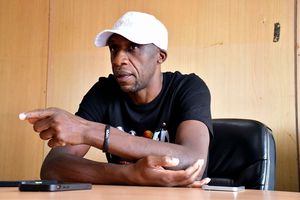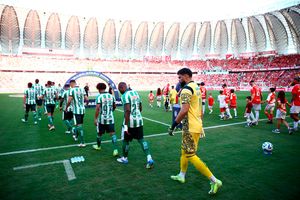
AFC Leopards fans during a Football Kenya Federation Premier League match against Gor Mahia at Nyayo National Stadium in Nairobi on March 30, 2025.
Once seen on stadium stands and terraces during football matches, they cannot be ignored.
They could be covered by dyed emissions from the smoke bombs they are holding high after igniting them. They could be chanting and jumping under the cover of a tifo they have unfurled. They could be standing behind banners and whipping giant flags over their heads, all proudly displaying the name, logo, and slogan of their fan group.
They exhibit passionate expressions of choreographed acts borrowed from European, North African, and South American fan culture that give players’ warm-ups, kick-offs, goal celebrations, and other key moments in a match, the cinematic aura of the opening montage of a blockbuster movie.
The football ultras fan culture has made a grand entry into Kenyan football, and AFC Leopards’ Ultras 1964 and Gor Mahia’s Ultras Green 1968 are making sure it is here to stay.
“We are the only Ultras in the Cecafa region,” 28-year old Evans “Tross” Otieno, a public relations practitioner, says proudly of Ultras Green 1968, the Gor Mahia fan group he formed in 2018 when he was a university student.
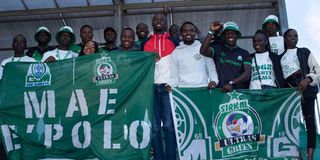
Members of Gor Mahia’s ‘Ultras Green 1968’ fans group display their banner after their team’s FKF Cup semifinal match against Murang'a Seal at the Dandora Stadium in Nairobi on May 26, 2025.
It is a tongue-in-cheek statement that can come from any self-respecting of K’Ogalo fan, one that never lets opportunity to taunt their fiercest rivals pass.
Yet, Mbakaya Milimu, a 40-year old IT professional, a diehard Ingwe fan is less dismissive and sees both fan groups as pioneers.
“I bet Ultras 1964 and Ultras Green 1968 are the only football ultras in sub-Saharan Africa,” he says, discernibly paying tribute to the ultras of North African football teams who have inspired the emergence of the culture in Kenyan football.
Otieno, formed Ultras Green 1968 after being fascinated by Ultras Green Boys, a vibrant fan group of 13-time Moroccan top flight champions, Raja Casablanca.
Global practice among ultras
“They inspired our name – Ultras Green 1968,” he says before adding that the name also allowed the group not to infringe on the club’s trademarks – Gor Mahia’s name and logo.
“Gor Mahia wears green and was founded in 1968. That is why we are Ultras Green 1968,” he adds.
Ultras Green 1968 are now active on Facebook, Instagram, TikTok, and Twitter (X), platforms they use to connect with other ultras globally.
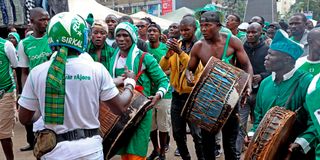
Gor Mahia fans on the streets of Nairobi before their FKF Premier League match against AFC Leopards at Nyayo National Stadium on May 14, 2023.
It – ultras settling on an identity that does not associate with their club directly – is also what guided the naming of Ultras 1964. AFC Leopards was founded in 1964.
“It is a global practice among football ultras to forge their own identity,” Mbakaya explains.
The logo of Ultras Green 1968 features a green and white roundel surrounding a football animated to depict a menacing face with gnashed teeth and red eyes.
“Ultras have to be intimidating. We have to strike fear in opponents and boost the morale of our players,” Otieno says.
Intimidation of opponents
Ultra Greens 1968 have created banners bantering fans and players of rival teams while putting the names and faces of Gor Mahia players and renowned Luo politicians on flags.
They have flags of players like Austin Odhiambo, Benson Omalla, Enock Morrision, and even the late Tom Mboya, who played a key role in the club’s formation in 1968, a year before his assassination.
“When Omalla struggled for form in the 2023/24 season, we created a poster with his face and name on it. Raila Odinga signed the poster and we presented it to Omalla. After that, he recovered his form to win the Golden Boot and help Gor Mahia defend their league title,” Otieno recalls how Ultras Green 1968 once boosted a player’s morale.
This support for their team’s players and intimidation of opponents is often choreographed, as Milimu reveals. He narrates an incident from AFC Leopards’ 3-1 league win away to Talanta on June 15.
In the reverse fixture, Talanta had defeated Leopards 4-2 with one of their scorers, Emmanuel Osoro, shoving the ball over the line with his backside, invoking the wrath of Ingwe fans.
With 15 goals this season, Osoro is a Golden Boot contender who scored Talanta’s winning goals in their recent victories over Gor Mahia, KCB, and Tusker. Wary of the threat he poses, Ultras 1964 set out to destabilise him by taunting him throughout the match, starting from when he stepped onto the pitch for the warm up.
“We unsettled him and as a result, he struggled against us and we won the match,” Milimu says.
Other tactics used by the ultras involve chanting a player’s name after he makes an error or gets a yellow card to encourage him. They also ignite firecrackers when their team is down.
“When our players hear that, they wake up,” Milimu says as he jabs his finger upwards. “We always inform the club and the players what we plan to do during the match so that they are not caught off-guard,” he adds.
Colourful choreography and fanatical support of their teams are aspects of ultras fan culture that Ultras Green 1968 and Ultras 1964 have copied from foreign contemporaries.
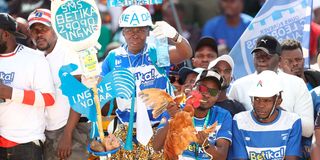
AFC Leopards fans during the Mashemeji derby at Nyayo National Stadium on March 30, 2025.
However, they have steered clear of the unsavoury characteristics that define ultras in other parts of the world – heavily tattooed football hooligans, serving as militia for political parties, ticket-touting, and involvement in sophisticated crimes like drug-trafficking.
“We only strive to emulate the positive elements of ultras fan culture,” Otieno says. “In our fan group we always insist that our members buy tickets and club merchandise from authorised merchants, and abstain from hooligan behaviour,” he adds.
“We are more interested in creating a lively atmosphere at matches,” Milimu, on his part, says while terming the area of the stadium Ultras 1964 occupy at matches as the “corner of vibrancy”.
While Ultras Green 1968 was founded much earlier in 2018, Ultras 1964 owes its existence to the sprouting of #FootballKE. #FootballKE, initiated by Milimu and other similar-minded individuals, is an online community of Kenyan football enthusiasts with a strong presence on X.
On WhatsApp, the movement is an umbrella with several splinter groups that cater for the community’s diverse interests – content creation, punters, recreational footballers, supporting women’s football, travelling for away matches, and ultras.
It was in 2022 that Ultras Green 1968 intensified its activities after Otieno met like-minded Gor Mahia fans on #FootballKE. Among them was 33-year old Oduor Owino, who was in search of a fresh outlet for expressing his devotion to the club.
Generational gaps and shifting socio-cultural dynamics, the peripatetic nature of Nairobi residence, and focus on contributing funds for burial and funeral arrangements (an aspect of their operation that has even concerned Gor Mahia club chairman Ambrose Rachier), had made Gor Mahia fan branches less attractive to join.
“I struggled to fit in as a member of a Gor Mahia fan branch. There was always a funeral contribution and since they are based around neighbourhoods, changing residence could mean joining a new branch. Ultras Green 1968 offers more flexibility and I mingle more with people of my age group,” Oduor, an architect, says.
Oduor also finds Ultras Green 1968 to be more inclusive as its set-up makes it easy for non-Luo Gor Mahia fans, or Luos who cannot speak the language, to join. “These are people who would otherwise struggle to be members of a Gor Mahia fan branch, which are predominantly Luo,” Otieno chimes in.
'Mae e polo'
Rural-urban migration over the last seven decades, as Oduor and Otieno posit, has birthed a generation of Luos who cannot speak the language, rendering them as misfits in social gatherings anchored on proficiency in the language.
“It is a challenge that Kenyans from other communities also face,” they add.
Yet, the slogan of Ultras Green 1968 is “mae e polo”, a Luo phrase meaning “this is my heaven”. “I do not support any other team other than Harambee Stars and Gor Mahia. Gor Mahia is my heaven,” Oduor emphasizes. Ultras 1964's slogan is "your obsession, our pride".
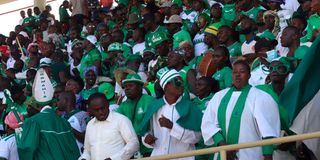
Gor Mahia fans Raila Odinga Stadium in Homa Bay town during the Mashemeji derby on June 2, 2025.
Still, as is the case of Ultras 1964, Ultras Green 1968, enjoys a good relationship with some Gor Mahia fan branches – notably Machakos and Rongai branches – that have taken notice of their efforts. Forming such alliances, as Milimu concurs, makes it easy for the group to pull off activities that require coordination with other branches.
For Ultras 1964, the group started becoming active this year despite being formed in 2022.
“Ultras Green 1968 took off quickly but we are catching up,” Milimu says but insists AFC Leopards fans pioneered certain aspects of ultras fan culture in Kenyan football in the past. “We were the first to do a Poznan,” he says with a chuckle.
While there are many differences in how the two groups operate, both draw their membership from a core of 15-50 individuals who are mostly millennials and Gen-Zs.
The members are also from diverse professional backgrounds, with some being accountants, doctors, engineers, nurses, pharmacists, and university students. “We even have ladies in our group,” says Otieno.
Ultras Green 1968 and Ultras 1964 also require their members to be registered members of Gor Mahia and AFC Leopards respectively and contribute actively to the fan group’s operations, which Milimu describes as “not cheap” and “time-consuming.”
“Before matches, we have meetings online and physically to plan our matchday activities, and travel for away matches if necessary. Those lagging behind get kicked out,” he says emphatically, insisting members should contribute to the group's growth either financially, giving their time, or sharing ideas.
From their revelations, standing out as a football ultras fan group in Kenyan football may require up to Sh1 million per season, if the ultras go all in for every match. A smoke bomb costs Sh800 and a flare goes for Sh1, 200, twice the price of a packet of firecrackers. A tifo requires nothing less than Sh55,000 as it involves procuring fabric and paying artists and designers.
The ultras buy 10-20 smoke bombs per match, on top of filling a fire extinguisher with smoke dyed in their respective club colours. They also travel to matches and buy tickets, food, and refreshments.
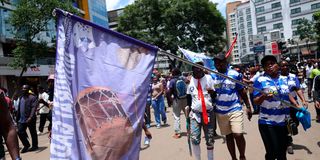
AFC Leopards fans march on the streets of Nairobi on March 30, 2025 ahead of the Mashemeji derby.
“We always raise money to buy these things but at times, when we are strained, we forego and reserve the choreography and pyrotechnics for big matches,” Otieno says. For Ultras 1964, they benefit from funding from benevolent Gen-Xers and Leopards fans in the diaspora. “We have created an industry where some people are making money from ultras,” Milimu says boastfully.
Still, despite the straining expenses, the trio sees value in being ultras. “We are not only spicing up our football but we are also helping Kenyan players prepare for matches against North African teams,” Milimu says.
On their part, Otieno and Oduor, express plans of going bigger next season. They plan to procure Bluetooth speakers, big marching drums, and megaphones. “The football ultras are here. We must be seen and heard,” they say.

